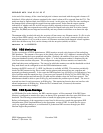15.1.3. Overview of the DB2 Recovery Process
Upon discovering a damaged DB2 container, you must first determine the level of hardware recovery and
problem determination available to you. For example, whether or not you were utilizing some level of
RAID and can recover a failed disk from a good disk. The second step in recovering damaged or
inaccessible DB2 containers is considering any software recovery tools available. For example, if you
were utilizing backup software, such as TSM, this would enable you to replace the bad hardware and
recover onto the new hardware device to a particular point in time. For details on recovering a DB2
database, see the IBM redbook titled “Data Recovery and High Availability Guide and Reference” for the
appropriate version of DB2 installed on your system. This guide will help you decide how best to recover
your DB2 database or damaged container.
15.2. HPSS System Environmental Backup
The HPSS administrator must also ensure that the HPSS system environment is backed up on a regular
basis and to verify that the backups can be used to restore the environment. The following sections
describe the environmental data that must be safeguarded.
15.2.1. HPSS Filesystem Backup
The following HPSS filesystems should be backed up using the site backup procedure:
• /opt/hpss
• /var/hpss
• /var/hpss/adm/core
• {HPSS metadata backup path}/cfg
• {HPSS metadata backup path}/subsys1
• /db2/backups/ldap (if LDAP is used)
• /var/hpss/hpssdb
• /var/hpss/hpssdb/ldap (if LDAP is used)
• {DB2 log path}/cfg
• {DB2 log path}/subsys1
• {DB2 log path}/ldap (if LDAP is used)
• {DB2 log archive path}/cfg
• {DB2 log archive path}/subsys1
• {DB2 mirror log path}/cfg
• {DB2 mirror log path}/subsys1
• {DB2 mirror log archive path}/cfg
• {DB2 mirror log archive path}/subsys1
• {HPSS secondary metadata backup path}/cfg
HPSS Management Guide November 2009
Release 7.3 (Revision 1.0) 359


















